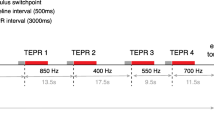Abstract
The human pupillary control system is a paradigm for linearized biological control systems. It also exhibits a series of interesting nonlinear behaviors, particularly asymmetry, “pupillary escape”, and “pupillary capture.” We present a nonlinear model in which a signal dependent upon pupil size is fed back internally to cause a change in system parameters related to gains and rates of light adaptation. The model was simulated on a digital computer, a variety of experimental data was well matched, and improvements over previous pupil models demonstrated. A candidate physiological mechanism for adaptive components of the model might have the form of an inverse “Henneman coded” neuronal pool.
Similar content being viewed by others
References
Clynes, M.: Unidirectional rate sensitivity: a biocybernetic law of reflex and humoral systems as physiologic channels of control and communication. Ann. Acad. Sci. 92, 946–969 (1961)
Hansmann, D., Semmlow, J., Stark, L.: A physiological basis of pupillary dynamics. In: Pupillary dynamics and behavior, Janisse, M.P., (ed.) New York: Plenum Press 1974 pp. 39–73
Lowenstein, O., Loewenfeld, I.E.: Effect of various light stimuli. In: Davson, H. (ed.). New York: Academic Press 1969, p. 274
Myers, G. Anchetta, J., Hannaford, B., Peng, P., Sherman, K. Stark, L., Sun, F., Usui, S.: Pupillometry: a bioengineering overview. Proc. 17th Ann. Conf. on Manual Control, UCLA, CA, June 16–18, pp. 523–536 (1981)
Sandberg, A., Stark, L.: Wiener G-functional analysis as an approach to non-linear characteristics of human pupil light reflex. Brain Res. 11, 194–211 (1968)
Semmlow, J., Stark, L., Simulation of a biomechanical model of the human pupil. Math. Biol. 11, 109–128 (1971)
Semmlow, J., Chen, D.: A simulation model of the human pupil light reflex. Math. Biol. 33, 5–24 (1977)
Semmlow, J., Stark, L.: Pupil movement to light and accommodative stimulation: a comparative study. Vision Res. 13, 1087–1100 (1973)
Shimizu, Y., Stark, L.: Pupillary escape. 10th Symp. on the Pupil, New York (1977)
Sobel, I., Stark, L.: Re-evaluation of the pupil system. Res. Lab. Elec. MIT, Q. Prog. Rep. 66, 412–419 (1962)
Stark, L.: Stability, oscillations and noise in the human pupil servomechanism. Proc. IRE 47, 1925–1939 (1959)
Stark, L., Sherman, P.M.: A servoanalytic study of consensual pupil reflex to light. J Neurophysiol. 20, 17–26 (1957)
Sun, F., Stark, L.: Pupillary escape intensified by large pupillary size. Vision Res. 23, 611–615 (1983)
Sun, F., Myers, G., Stark, L.: High pass filter characteristics of the pupil controlled by operating level. IEEE Trans. BME (1982) (submitted)
Sun, F., Zhau, X., Dai, S., Liu, H., Yan, R.: Dynamic characteristics of the pupillary control system: measurement and mathematical model. Acta Aut. Sin. 5, 130–135 (1979)
Sun, F., Liu, H., Liu, Y.: Dynamic pupillary response to positive differential of light stimulus, Sci. Sin. 24, 872–884 (1981)
Troelstra, A.: Detection of time-varying light signals as measured by the pupillary response. J. Opt. Soc. Am. 58, 685–690 (1968)
Usui, S.: Functional organization of the human pupillary light reflex system: Ph.D. thesis, UC Berkeley, p. 86, 1974
Webster, J.: Pupillary light reflex: development of teaching models. IEEE Trans. BME 18, 187–194 (1971)
Author information
Authors and Affiliations
Additional information
Visiting Professor on leave from Shanghai institute of Physiology, Shanghai, China
Rights and permissions
About this article
Cite this article
Sun, F., Krenz, W.C. & Stark, L.W. A systems model for the pupil size effect. Biol. Cybern. 48, 101–108 (1983). https://doi.org/10.1007/BF00344393
Received:
Issue Date:
DOI: https://doi.org/10.1007/BF00344393




